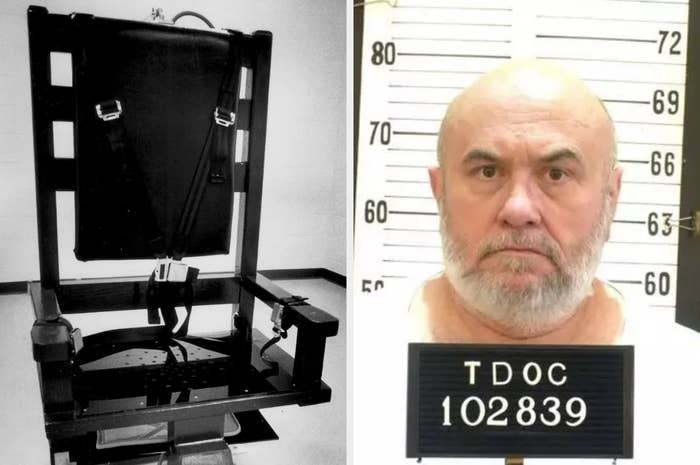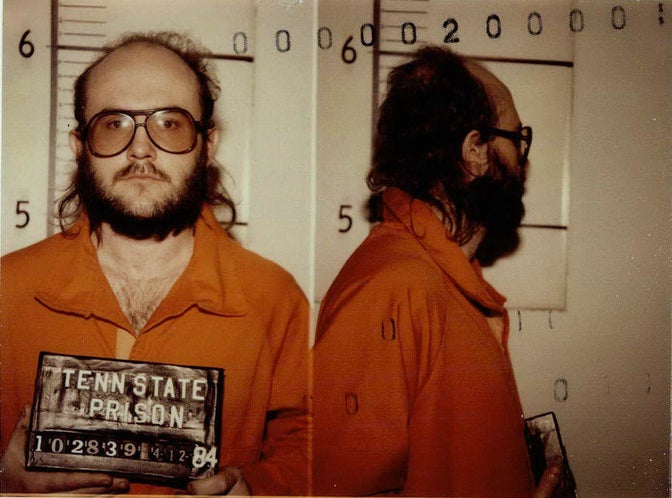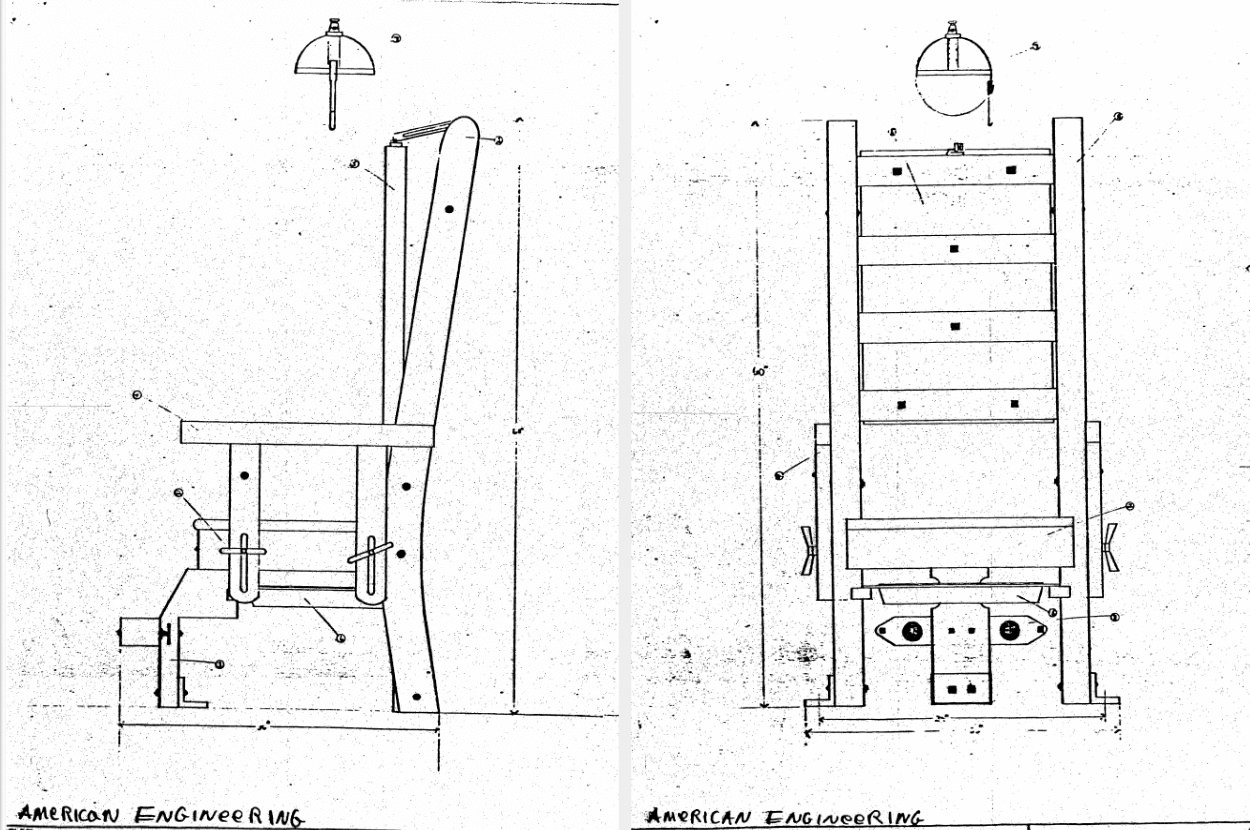
A Tennessee death row prisoner hoping to avoid a lethal injection he believes would be "torture" just won a major victory in his battle to choose how the state will kill him. If Edmund Zagorski is to be executed, a federal judge ruled on Thursday, the state will have to use the electric chair.
The decision, if it holds, would result in the first electric chair death in Tennessee since 2007, and the first in the US since 2013. Gov. Bill Haslam granted a 10-day reprieve to Zagorski on Thursday to "give all involved the time necessary to carry out the sentence in an orderly and careful manner." Although dying by electrocution can be incredibly gruesome, it’s more reliably lethal than drug injections. Until the 1990s, electric chairs were common across the country. But all states eventually turned to lethal injection as their primary choice, over concerns that electric chairs were too barbaric, particularly for viewers. Nine states permit the use of the electric chair, but just two — Virginia and South Carolina — have used one in the past 10 years.
Documents obtained by BuzzFeed News show the original 1985 sales pitch for the construction of Tennessee's current machine, as well as reservations by its creator — a Holocaust denier who falsely presented himself to the Tennessee Department of Correction as an engineer — decades later, when he feared that modifications would make the chair "an instrument of torture." He stands by that assessment today.
“I think it should be retired,” Fred Leuchter Jr., who installed the chair and then objected to the modifications made to it years later, told BuzzFeed News. “We’re going to have a major fiasco where the world is going to see that there’s something wrong.”
On at least one occasion after the chair was installed, experts disagreed about the exact configuration of current and voltage that would lead to a humane death. The documents also include several versions of a checklist for operating the chair, one of which ends with the instruction: “LEAVE EXHAUST FAN ON!!!”
The inmate who wants to die in this chair, 63-year-old Zagorski, was convicted for the murder of two men in April 1983. Zagorski lured John Dotson and Jimmy Porter into the woods in northern Tennessee, under the pretense that they were buying at least 100 pounds of marijuana. According to court documents, Zagorski instead shot and slit the throats of the two men, and took the thousands of dollars that they brought for the drugs. He was sentenced to death a year later.
Of the 30 states that still have the death penalty, 21 do not have the electric chair as an option. And two of those states have explicitly ruled that electrocution is unconstitutionally cruel: In Georgia’s ruling banning the device’s use, for example, the state Supreme Court cited expert testimony suggesting the alternating current “could repetitively activate the brain, causing the perception of excruciating pain and a sense of extreme horror.” Experts in that case had also said that the voltage sequence used in the execution could stop the heart, only to start it up again.
The Nebraska court, in its ruling, cited expert testimony claiming that a chair caused a prisoner’s skin to reach “a temperature of 200 degrees.” It noted that protocol required a fire extinguisher be kept nearby, and that witnesses of past executions had described smoke emerging from a prisoner’s leg, and reported smelling burning flesh in the viewing room.
Both court rulings mentioned the possibility of burns to the head from “the sloughing or ‘slippage’ of a large portion of the scalp,” and “sagging skin on the sides of the prisoner's head from the temple areas and cheeks to above and behind the ears.”
Although the electric chair can result in grisly outcomes, lethal injection actually has a higher rate of botched attempts than electrocution. Tennessee, like several other states, employs a three-drug lethal injection protocol: first a sedative akin to Valium, then two incredibly painful drugs — a paralytic and potassium chloride. If the inmate is not properly anesthetized by the first drug, the final two drugs would feel like being buried alive and then burned alive, according to medical experts. The sedative Tennessee hopes to use, midazolam, has been implicated in several botched executions over the past few years.
Although the electric chair can result in grisly outcomes, lethal injection actually has a higher rate of botched attempts than electrocution.
Zagorski, along with dozens of other death row inmates, sued the state, arguing this method constitutes cruel and unusual punishment. On Monday, three days before Zagorski’s scheduled execution, the Tennessee Supreme Court disagreed, finding that the inmates had not met their burden of coming up with a better way to be killed. The inmates had proposed using another drug, but the state said it couldn’t be obtained.
Within hours of Monday’s ruling, Zagorski asked to be killed by the electric chair, to avoid a lethal injection he says would be torture. In Tennessee, inmates sentenced to death before 1999 have a choice between the chair and lethal injection.
But the Tennessee Department of Correction swiftly rejected his request. The state argued that Zagorski needed to make his decision weeks before, by Sept. 27. TDOC Deputy Commissioner of Administration and General Counsel Debra Inglis told Zagorski’s attorney that he would have to die by lethal injection.
On Wednesday, Zagorski’s lawyer filed an emergency motion to compel the state to consider his request, arguing the deadline the state set was arbitrary and not in the statute. On Thursday, a federal judge ruled in Zagorski’s favor and prohibited the state from executing the inmate by any method other than the electric chair.
Zagorski’s execution is still on hold, however. Late on Wednesday, the US Court of Appeals for the Sixth Circuit stayed his execution over concerns that he had inadequate representation during his original trial in 1984.
“Tennessee’s death penalty statute makes it clear that Mr. Zagorski has the right to choose execution by electrocution,” Kelley Henry, an attorney for Zagorski, said in an emailed statement. “While being burned alive and mutilated via electricity is not a good death, Mr. Zagorski knows that death by electric chair will be much quicker than lethal injection using midazolam, a paralytic, and potassium chloride.”

BuzzFeed News asked the state’s Department of Correction for the chair’s execution protocols, manuals, logs of quarterly equipment checks, and related records. The documents show that the state’s current chair was made by Leuchter, a Massachusetts man who would eventually be charged with fraud for practicing engineering without a license. He was also the author of a report that attempted to show that the Holocaust gas chambers were not used to kill people.
Although Leuchter has been described as a Holocaust denier, he insists that the term has been used to tarnish his reputation. “I am not a denier of anything. You can’t deny something that didn’t happen,” he told BuzzFeed News. As to the fraud charges, he said that that case had settled, and that although his undergraduate degree was in history and not engineering, he was “fully qualified.”
Leuchter had advised more than a dozen states on execution equipment of various types, but by 1990, according to a New York Times report at the time, states were finding that his methods fell short. The Illinois Department of Corrections terminated his contract after an expert testified that one machine, used to inject potassium cyanide, “would cause the prisoner unnecessary pain, consisting of a severe burning sensation.”
Starting in 1985, documents show, he corresponded with the Tennessee State Penitentiary about the benefits of his electrocution machine. In October 1987, he sent a quote for execution equipment to a warden, noting that the company had equipment in many states throughout the US, “including hardware for electrocution, lethal injection, Gas chambers, and gallows.”
Leuchter completed the installation of the electrocution system at the Riverbend Maximum Security Institution in November 1989. A purchase order dated June 1989 and issued to Fred A Leuchter Associates Inc. indicates he was paid $41,844 for “movement, renovation, and repair of the electrical equipment,” including labor and materials. Additionally, the state purchased a “modular power supply test unit” for $5,900.
A manual that Leuchter provided to Riverbend included detailed descriptions of how the chair worked, instructions on how to disengage the prisoner after the execution, and how to clean the chair.
According to this manual, the chair itself was made of oak — Leuchter claimed it included wood from Tennessee’s first electric chair — and had an adjustable backrest, as well as a removable drip pan. Its two ankle electrodes were made of brass, and a third electrode — a “tightly fitting cap” — would ensure that the current would pass “through the complete trunk of the subject’s body.”

There were also medical notes about the device explaining that one had to consider both the “conscious and the autonomic nervous system” for the best outcome. Calculations for “an average man weighing 70 kilos” estimated the right voltage that would stop the heart and “minimize body damage (cooking).” One version of the manual included the disclaimer that the company “assumes no liability for the intended or actual use of this device.”
Leuchter trained 19 employees and even made his own certificates to say that each was an “Electrocution Technician.”
The documents also revealed that technical experts disagreed sharply on the most humane way to administer an electric current with the goal of killing a person.
In April 1994, as part of a lawsuit, an outside expert visited the prison, inspected the equipment and wrote in a report to the state attorney general that the electric current typically used was too low and that the machine “does not seem to have the capacity to function with a typical load for an execution.”
The facility hired an engineer from Arkansas, Jay Wiechert, who helped implement a series of modifications, including increasing the amount of current that would flow during an execution, and changing the timing of the electrocution cycle.
But the Leuchter camp disagreed with those changes.
“These modifications may result in ‘tissue cooking’ of the executee, and further, fibrillation of the executees heart resulting in failure to execute and a brain dead vegetable at the conclusion of the execution procedure,” John V. Maye, president of JVM, the firm that had acquired rights to Leuchter’s designs and technology, wrote to the associate warden at Riverbend in April 1996.
Maye called the modifications, particularly the change in cycle timing, “dangerous” and said that the changes voided the guarantee with Leuchter’s firm, which JVM had now acquired.
“We bear no legal liability in this matter except to advise you of these conditions and the possibility of torture of the inmate if an execution is carried out with the modified equipment.”
Leuchter himself believes that Wiechert wanted to punish executees for their crimes. “I think he believed in torturing the executee because of the crimes they committed, so he deliberately designed equipment that hurt,” he told BuzzFeed News. (Wiechert died in 2016.)
Riverbend warden Ricky Bell replied in September that year asking that JVM provide documentation “that the system will not function as expected, and further, to refute the modifications recommended” by the other two experts. (No reply was ever received, he wrote in a 2006 memo.)
Wiechert continued to visit and examine the equipment through at least 2007 — the year it was used for the first time, to execute convicted murderer Daryl Holton.
The day before Holton’s execution, Leuchter told the City Paper that he had reservations about if the chair would work — he worried that the voltage was too low and that the chair would fall short of its lethal goal, leaving the inmate brain dead. He reportedly even petitioned then-Tennessee Gov. Phil Bredesen to halt its use.
Holton did die. His body tensed and arched upward with each of the two blows of electricity, according to a news report.
Zagorski would be only the second person to die in the chair since. “I don’t want to be tortured with those drugs,” he told the Nashville Scene earlier this week, “but I am not afraid of death.”
UPDATE
This story has been updated with comments from Fred Leuchter, Jr.
CORRECTION
Jimmy Porter's name was misspelled in an earlier version of this post.

